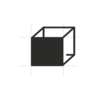ALLPLAN Bridge
MODELING OF PRECAST GIRDER BRIDGES
The geometry of precast girders is governed by the geometry of the substructure and their position along the axis. Thus, a further modeling approach is available in ALLPLAN Bridge that enables users to create an exact geometry of precast girder bridges easily and quickly.
A DEDICATED WORKFLOW FOR PRECAST GIRDER BRIDGES
The modeling process is optimized even further by using parametric 3D templates. In this way repetitive bridge elements, such as straight precast girders, have to be defined only once and then placed parametrically as many times as necessary.

1. CREATING AXES
Every bridge construction project starts with one or more axes – with ALLPLAN Bridge, you can adopt the data from an existing design (using LandXML data format) or define it manually. In both cases, the alignment is parametrically saved.

2. DEFINING A CROSS-SECTION
You can define any cross-section and determine the geometry with its dependencies and variables. These parametric cross-sections can be adapted at any time and can be saved as a template and reused.

3. DESIGNING A TEMPLATE
Any geometry of a pier, foundation and precast girder can be defined as a template. In the previous step defined cross-section(s) including constant and variable parameters are used for the design of the template. If the geometry is variable, tables or formulas can be assigned as usually. Furthermore, you can set which parts of the template should be fixed and which should adjust when using it in the 3D Model.

4. BUILDING A SUBSTRUCTURE
The substructure, with or without foundations, can be defined relative to one axis or relative to two axes – for example terrain axis at the bottom and road axis at the top. It can be defined directly or by usage of templates.

5. ASSEMBLING GIRDERS
Precast girders are, just like on the construction side, positioned on the substructure created in the previous step. Actually, they are positioned between 2 reference points (bearings). The exact position of reference points is set by the substructure geometry.

6. CONSTRUCTING A PLATE
For generating the plate geometry, the original workflow of ALLPLAN Bridge is used – extruding the geometry along the axis. Also, here any variations can be used and the cross-section, and with this also the 3D model, can be equipped with all the details, either by using boundaries or by placing python parts.

7. COMPOSING THE HAUNCH
In precast girder bridges the shape of the girders is governed by the geometry of the substructure, whereas on the other side, the geometry of the plate is governed by the axis. This is why the shape of the haunch has an arbitrary 3D geometry and varies along the girder. ALLPLAN Bridge 3D Boolean operations are used to automatically fill the space between the girder and plate, using the shape of the haunch defined in the girder cross-section.

8. COMPLETING THE BRIDGE STRUCTURE
Once the main bridge elements are finished, further elements and details, like tendons, diaphragms, bearings and many more, can be generated. This can be done by modeling them or by placing parametric elements – python parts.